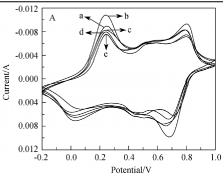| [1] |
李萍, 杨琪玉, 曾婧, 张然, 陈秋燕, 闫飞. 氟掺杂对可逆固体氧化物电池性能的影响及相关动力学研究[J]. 化学学报, 2024, 82(1): 36-45. |
| [2] |
刘士琨, 邓程维, 姬峰, 闵宇霖, 李和兴. 高温质子交换膜燃料电池中阴极双催化层孔结构的设计研究★[J]. 化学学报, 2023, 81(9): 1135-1141. |
| [3] |
张欣欣, 刘荣, 王蕾, 付宏刚. 细菌纤维素基柔性锌离子电池正极的构筑及性能研究[J]. 化学学报, 2021, 79(5): 670-677. |
| [4] |
李燕丽, 于丹丹, 林森, 孙东飞, 雷自强. α-MnO2纳米棒/多孔碳正极材料的制备及水系锌离子电池性能研究[J]. 化学学报, 2021, 79(2): 200-207. |
| [5] |
梁其梅, 郭昱娇, 郭俊明, 向明武, 刘晓芳, 白玮, 宁平. 亚微米去顶角八面体LiNi0.08Mn1.92O4正极材料制备及高温电化学性能[J]. 化学学报, 2021, 79(12): 1526-1533. |
| [6] |
渠璐平, 任彤, 王宁, 史月丽, 庄全超. 硬碳材料电极首周嵌钠过程的电化学阻抗谱研究[J]. 化学学报, 2019, 77(7): 634-640. |
| [7] |
宋学霞, 李继成, 李朝晖, 李喜飞, 丁燕怀, 肖启振, 雷钢铁. 钾掺杂对钒酸钠纳米片储钠性能的影响[J]. 化学学报, 2019, 77(7): 625-633. |
| [8] |
常世磊, 梁风, 姚耀春, 马文会, 杨斌, 戴永年. 金属二氧化碳电池的研究进展[J]. 化学学报, 2018, 76(7): 515-525. |
| [9] |
郑媛, 罗静, 魏玮, 刘晓亚. Pickering乳液法制备聚苯胺-石墨烯空心微球[J]. 化学学报, 2017, 75(4): 391-397. |
| [10] |
杨春, 龚正良, 赵文高, 杨勇. 富锂正极材料xLi3NbO4·(1-x)LiMO2(M=Mn,Co;0 < x < 1)的制备及电化学性能研究[J]. 化学学报, 2017, 75(2): 212-217. |
| [11] |
刘清朝, 马诗喻, 徐吉静, 李中军, 张新波. 锂-空气二次电池关键材料与器件的设计与制备[J]. 化学学报, 2017, 75(2): 137-146. |
| [12] |
孔丽娟, 周晓燕, 范赛英, 李在均, 顾志国. 组氨酸功能化石墨烯量子点@纳米硅负极材料的制备及电化学性能研究[J]. 化学学报, 2016, 74(7): 620-628. |
| [13] |
许智慧, 沈丽明, 吴强, 孙涛, 徐宇洋, 黎聃勤, 杜玲玉, 杨立军, 王喜章, 胡征. 热解聚苯胺/碳纳米笼复合物制备氮掺杂碳材料及其氧还原性能研究[J]. 化学学报, 2015, 73(8): 793-798. |
| [14] |
韩若冰, 芦姗, 王艳杰, 张雪华, 吴强, 贺涛. SO4-和I-共掺杂的聚苯胺对电极在染料敏化太阳电池中的应用[J]. 化学学报, 2015, 73(10): 1061-1068. |
| [15] |
高珍珍, 佟浩, 陈建慧, 岳世鸿, 白文龙, 张校刚, 潘燕飞, 石明, 宋玉翔. 聚苯胺共价接枝碳纳米管复合材料的制备及其超电容性能的研究[J]. 化学学报, 2014, 72(11): 1175-1181. |
